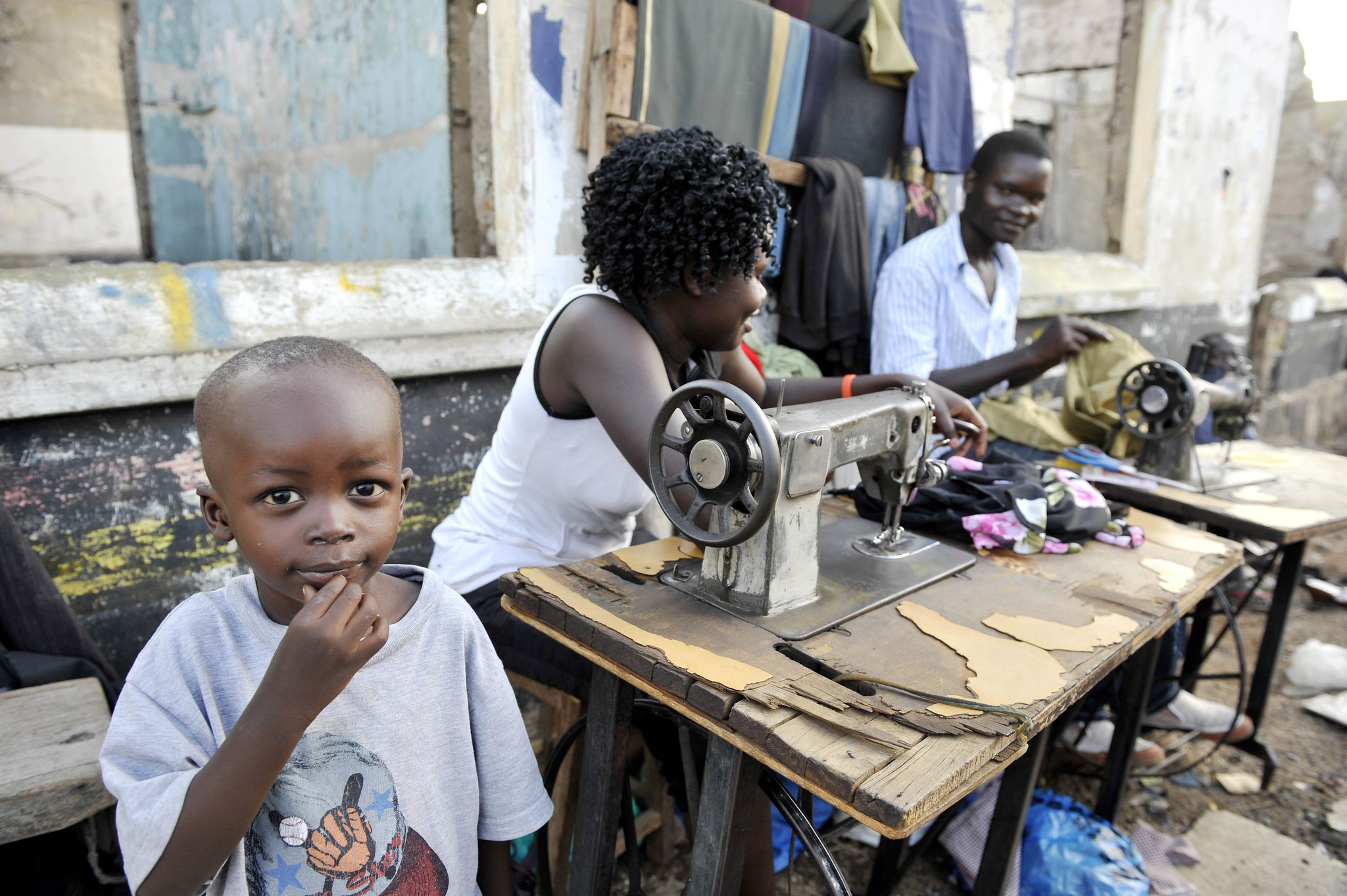Table of Contents
Introduction
Equal opportunity and equal treatment in the labour market are at the core of decent work. Unfortunately, women around the world still face additional hurdles to access employment, and once in employment, to access decision-making positions and jobs in certain sectors or of certain characteristics. This horizontal and vertical gender segregation of employment, combined with the unequal distribution of unpaid work (including household and childcare activities), results in differences in working conditions such as the gender pay gap and the over-representation of women in part-time jobs.
Gender equality is crucial to economic growth and sustainable development. It is recognized as a cross-cutting objective within the ILO’s Decent Work Agenda, and as a key goal within the 2030 Agenda for Sustainable Development. In fact, Goal 5 of the SDGs is devoted specifically to achieving gender equality and the empowerment of women and girls, but gender equality is also mainstreamed throughout the other sixteen goals.
Data catalogue
Below are a subset of the indicators available by sex. See the main data catalogue for more.
| Indicator | Frequency | Database | Subject | Download (with labels) | Download (with codes) | Data explorer |
|---|---|---|---|---|---|---|
| Working-age population by sex, age and marital status (thousands) | Annual | Gender Equality and Non-Discrimination Indicators (GEND) | Population | .csv .dta .xlsx | .csv.gz | |
| Working-age population by sex and marital status (thousands) | Annual | Gender Equality and Non-Discrimination Indicators (GEND) | Population | .csv .dta .xlsx | .csv.gz | |
| Working-age population by sex, marital status and labour market status (thousands) | Annual | Gender Equality and Non-Discrimination Indicators (GEND) | Population | .csv .dta .xlsx | .csv.gz | |
| Prime-age population by household type (thousands) | Annual | Gender Equality and Non-Discrimination Indicators (GEND) | Population | .csv .dta .xlsx | .csv.gz | |
| Labour force by sex, age and marital status (thousands) | Annual | Gender Equality and Non-Discrimination Indicators (GEND) | Labour force | .csv .dta .xlsx | .csv.gz | |
| Labour force by sex and marital status (thousands) | Annual | Gender Equality and Non-Discrimination Indicators (GEND) | Labour force | .csv .dta .xlsx | .csv.gz | |
| Labour force participation rate by sex, age and marital status (%) | Annual | Gender Equality and Non-Discrimination Indicators (GEND) | Labour force | .csv .dta .xlsx | .csv.gz | |
| Labour force participation rate by sex and marital status (%) | Annual | Gender Equality and Non-Discrimination Indicators (GEND) | Labour force | .csv .dta .xlsx | .csv.gz | |
| Prime-age labour force participation rate by sex, household type and rural / urban areas (%) | Annual | Gender Equality and Non-Discrimination Indicators (GEND) | Labour force | .csv .dta .xlsx | .csv.gz | |
| Prime-age labour force participation rate by sex, household type and presence of children (%) | Annual | Gender Equality and Non-Discrimination Indicators (GEND) | Labour force | .csv .dta .xlsx | .csv.gz | |
| Employment by sex, age and marital status (thousands) | Annual | Gender Equality and Non-Discrimination Indicators (GEND) | Employment | .csv .dta .xlsx | .csv.gz | |
| Employment by sex and marital status (thousands) | Annual | Gender Equality and Non-Discrimination Indicators (GEND) | Employment | .csv .dta .xlsx | .csv.gz | |
| Employment by sex, status in employment and marital status (thousands) | Annual | Gender Equality and Non-Discrimination Indicators (GEND) | Employment | .csv .dta .xlsx | .csv.gz | |
| Employment by sex, economic activity and marital status (thousands) | Annual | Gender Equality and Non-Discrimination Indicators (GEND) | Employment | .csv .dta .xlsx | .csv.gz | |
| Employment by sex, occupation and marital status (thousands) | Annual | Gender Equality and Non-Discrimination Indicators (GEND) | Employment | .csv .dta .xlsx | .csv.gz | |
| Employment by sex, public/private sector and marital status (thousands) | Annual | Gender Equality and Non-Discrimination Indicators (GEND) | Employment | .csv .dta .xlsx | .csv.gz | |
| Employment by sex, establishment size and marital status (thousands) | Annual | Gender Equality and Non-Discrimination Indicators (GEND) | Employment | .csv .dta .xlsx | .csv.gz | |
| Employment by sex, weekly hours actually worked and marital status (thousands) | Annual | Gender Equality and Non-Discrimination Indicators (GEND) | Employment | .csv .dta .xlsx | .csv.gz | |
| Employment by sex, multiple job holding and marital status (thousands) | Annual | Gender Equality and Non-Discrimination Indicators (GEND) | Employment | .csv .dta .xlsx | .csv.gz | |
| Employment-to-population ratio by sex, age and marital status (%) | Annual | Gender Equality and Non-Discrimination Indicators (GEND) | Employment | .csv .dta .xlsx | .csv.gz | |
| Employment-to-population ratio by sex and marital status (%) | Annual | Gender Equality and Non-Discrimination Indicators (GEND) | Employment | .csv .dta .xlsx | .csv.gz | |
| Prime-age employment-to-population ratio by sex, household type and presence of children (%) | Annual | Gender Equality and Non-Discrimination Indicators (GEND) | Employment | .csv .dta .xlsx | .csv.gz | |
| Prime-age employment-to-population ratio by sex, household type and rural / urban areas (%) | Annual | Gender Equality and Non-Discrimination Indicators (GEND) | Employment | .csv .dta .xlsx | .csv.gz | |
| Informal employment by sex, age and marital status (thousands) | Annual | Gender Equality and Non-Discrimination Indicators (GEND) | Informal economy | .csv .dta .xlsx | .csv.gz | |
| Informal employment by sex and marital status (thousands) | Annual | Gender Equality and Non-Discrimination Indicators (GEND) | Informal economy | .csv .dta .xlsx | .csv.gz | |
| Informal employment by sex, economic activity and marital status (thousands) | Annual | Gender Equality and Non-Discrimination Indicators (GEND) | Informal economy | .csv .dta .xlsx | .csv.gz | |
| Informal employment by sex, occupation and marital status (thousands) | Annual | Gender Equality and Non-Discrimination Indicators (GEND) | Informal economy | .csv .dta .xlsx | .csv.gz | |
| Informal employment by sex, public/private sector and marital status (thousands) | Annual | Gender Equality and Non-Discrimination Indicators (GEND) | Informal economy | .csv .dta .xlsx | .csv.gz | |
| Informal employment by sex, establishment size and marital status (thousands) | Annual | Gender Equality and Non-Discrimination Indicators (GEND) | Informal economy | .csv .dta .xlsx | .csv.gz | |
| Informal employment rate by sex, age and marital status (%) | Annual | Gender Equality and Non-Discrimination Indicators (GEND) | Informal economy | .csv .dta .xlsx | .csv.gz | |
| Informal employment rate by sex and marital status (%) | Annual | Gender Equality and Non-Discrimination Indicators (GEND) | Informal economy | .csv .dta .xlsx | .csv.gz | |
| Informal employment rate by sex, economic activity and marital status (%) | Annual | Gender Equality and Non-Discrimination Indicators (GEND) | Informal economy | .csv .dta .xlsx | .csv.gz | |
| Informal employment rate by sex, occupation and marital status (%) | Annual | Gender Equality and Non-Discrimination Indicators (GEND) | Informal economy | .csv .dta .xlsx | .csv.gz | |
| Informal employment rate by sex, public/private sector and marital status (%) | Annual | Gender Equality and Non-Discrimination Indicators (GEND) | Informal economy | .csv .dta .xlsx | .csv.gz | |
| Informal employment rate by sex, establishment size and marital status (%) | Annual | Gender Equality and Non-Discrimination Indicators (GEND) | Informal economy | .csv .dta .xlsx | .csv.gz | |
| Employment outside the formal sector by sex, age and marital status (thousands) | Annual | Gender Equality and Non-Discrimination Indicators (GEND) | Informal economy | .csv .dta .xlsx | .csv.gz | |
| Employment outside the formal sector by sex and marital status (thousands) | Annual | Gender Equality and Non-Discrimination Indicators (GEND) | Informal economy | .csv .dta .xlsx | .csv.gz | |
| Employment outside the formal sector by sex, economic activity and marital status (thousands) | Annual | Gender Equality and Non-Discrimination Indicators (GEND) | Informal economy | .csv .dta .xlsx | .csv.gz | |
| Employment outside the formal sector by sex, occupation and marital status (thousands) | Annual | Gender Equality and Non-Discrimination Indicators (GEND) | Informal economy | .csv .dta .xlsx | .csv.gz | |
| Employment outside the formal sector by sex, public/private sector and marital status (thousands) | Annual | Gender Equality and Non-Discrimination Indicators (GEND) | Informal economy | .csv .dta .xlsx | .csv.gz | |
| Employment outside the formal sector by sex, establishment size and marital status (thousands) | Annual | Gender Equality and Non-Discrimination Indicators (GEND) | Informal economy | .csv .dta .xlsx | .csv.gz | |
| Share of employment outside the formal sector by sex, age and marital status (%) | Annual | Gender Equality and Non-Discrimination Indicators (GEND) | Informal economy | .csv .dta .xlsx | .csv.gz | |
| Share of employment outside the formal sector by sex and marital status (%) | Annual | Gender Equality and Non-Discrimination Indicators (GEND) | Informal economy | .csv .dta .xlsx | .csv.gz | |
| Share of employment outside the formal sector by sex, economic activity and marital status (%) | Annual | Gender Equality and Non-Discrimination Indicators (GEND) | Informal economy | .csv .dta .xlsx | .csv.gz | |
| Share of employment outside the formal sector by sex, occupation and marital status (%) | Annual | Gender Equality and Non-Discrimination Indicators (GEND) | Informal economy | .csv .dta .xlsx | .csv.gz | |
| Share of employment outside the formal sector by sex, public/private sector and marital status (%) | Annual | Gender Equality and Non-Discrimination Indicators (GEND) | Informal economy | .csv .dta .xlsx | .csv.gz | |
| Share of employment outside the formal sector by sex, establishment size and marital status (%) | Annual | Gender Equality and Non-Discrimination Indicators (GEND) | Informal economy | .csv .dta .xlsx | .csv.gz | |
| Employees by sex, age and marital status (thousands) | Annual | Gender Equality and Non-Discrimination Indicators (GEND) | Employees | .csv .dta .xlsx | .csv.gz | |
| Employees by sex and marital status (thousands) | Annual | Gender Equality and Non-Discrimination Indicators (GEND) | Employees | .csv .dta .xlsx | .csv.gz | |
| Employees by sex, economic activity and marital status (thousands) | Annual | Gender Equality and Non-Discrimination Indicators (GEND) | Employees | .csv .dta .xlsx | .csv.gz | |
| Employees by sex, occupation and marital status (thousands) | Annual | Gender Equality and Non-Discrimination Indicators (GEND) | Employees | .csv .dta .xlsx | .csv.gz | |
| Employees by sex, public/private sector and marital status (thousands) | Annual | Gender Equality and Non-Discrimination Indicators (GEND) | Employees | .csv .dta .xlsx | .csv.gz | |
| Employees by sex, establishment size and marital status (thousands) | Annual | Gender Equality and Non-Discrimination Indicators (GEND) | Employees | .csv .dta .xlsx | .csv.gz | |
| Time-related underemployment by sex, age and marital status (thousands) | Annual | Gender Equality and Non-Discrimination Indicators (GEND) | Time-related underemployment | .csv .dta .xlsx | .csv.gz | |
| Time-related underemployment by sex and marital status (thousands) | Annual | Gender Equality and Non-Discrimination Indicators (GEND) | Time-related underemployment | .csv .dta .xlsx | .csv.gz | |
| Time-related underemployment rate by sex, age and marital status (%) | Annual | Gender Equality and Non-Discrimination Indicators (GEND) | Time-related underemployment | .csv .dta .xlsx | .csv.gz | |
| Time-related underemployment rate by sex and marital status (%) | Annual | Gender Equality and Non-Discrimination Indicators (GEND) | Time-related underemployment | .csv .dta .xlsx | .csv.gz | |
| Unemployment by sex, age and marital status (thousands) | Annual | Gender Equality and Non-Discrimination Indicators (GEND) | Unemployment | .csv .dta .xlsx | .csv.gz | |
| Unemployment by sex and marital status (thousands) | Annual | Gender Equality and Non-Discrimination Indicators (GEND) | Unemployment | .csv .dta .xlsx | .csv.gz | |
| Unemployment by sex, duration and marital status (thousands) | Annual | Gender Equality and Non-Discrimination Indicators (GEND) | Unemployment | .csv .dta .xlsx | .csv.gz | |
| Unemployment rate by sex, age and marital status (%) | Annual | Gender Equality and Non-Discrimination Indicators (GEND) | Unemployment | .csv .dta .xlsx | .csv.gz | |
| Unemployment rate by sex and marital status (%) | Annual | Gender Equality and Non-Discrimination Indicators (GEND) | Unemployment | .csv .dta .xlsx | .csv.gz | |
| Prime-age unemployment rate by sex, household type and presence of children (%) | Annual | Gender Equality and Non-Discrimination Indicators (GEND) | Unemployment | .csv .dta .xlsx | .csv.gz | |
| Prime-age unemployment rate by sex, household type and rural / urban areas (%) | Annual | Gender Equality and Non-Discrimination Indicators (GEND) | Unemployment | .csv .dta .xlsx | .csv.gz | |
| Combined rate of time-related underemployment and unemployment (LU2) by sex, age and marital status (%) | Annual | Gender Equality and Non-Discrimination Indicators (GEND) | Other measures of labour underutilization | .csv .dta .xlsx | .csv.gz | |
| Combined rate of time-related underemployment and unemployment (LU2) by sex and marital status (%) | Annual | Gender Equality and Non-Discrimination Indicators (GEND) | Other measures of labour underutilization | .csv .dta .xlsx | .csv.gz | |
| Prime-age combined rate of time-related underemployment and unemployment (LU2) by sex, household type and presence of children (%) | Annual | Gender Equality and Non-Discrimination Indicators (GEND) | Other measures of labour underutilization | .csv .dta .xlsx | .csv.gz | |
| Prime-age combined rate of time-related underemployment and unemployment (LU2) by sex, household type and rural / urban areas (%) | Annual | Gender Equality and Non-Discrimination Indicators (GEND) | Other measures of labour underutilization | .csv .dta .xlsx | .csv.gz | |
| Combined rate of unemployment and potential labour force (LU3) by sex, age and marital status (%) | Annual | Gender Equality and Non-Discrimination Indicators (GEND) | Other measures of labour underutilization | .csv .dta .xlsx | .csv.gz | |
| Combined rate of unemployment and potential labour force (LU3) by sex and marital status (%) | Annual | Gender Equality and Non-Discrimination Indicators (GEND) | Other measures of labour underutilization | .csv .dta .xlsx | .csv.gz | |
| Prime-age combined rate of unemployment and potential labour force (LU3) by sex, household type and presence of children (%) | Annual | Gender Equality and Non-Discrimination Indicators (GEND) | Other measures of labour underutilization | .csv .dta .xlsx | .csv.gz | |
| Prime-age combined rate of unemployment and potential labour force (LU3) by sex, household type and rural / urban areas (%) | Annual | Gender Equality and Non-Discrimination Indicators (GEND) | Other measures of labour underutilization | .csv .dta .xlsx | .csv.gz | |
| Composite rate of labour underutilization (LU4) by sex, age and marital status (%) | Annual | Gender Equality and Non-Discrimination Indicators (GEND) | Other measures of labour underutilization | .csv .dta .xlsx | .csv.gz | |
| Composite rate of labour underutilization (LU4) by sex and marital status (%) | Annual | Gender Equality and Non-Discrimination Indicators (GEND) | Other measures of labour underutilization | .csv .dta .xlsx | .csv.gz | |
| Prime-age composite rate of labour underutilization (LU4) by sex, household type and presence of children (%) | Annual | Gender Equality and Non-Discrimination Indicators (GEND) | Other measures of labour underutilization | .csv .dta .xlsx | .csv.gz | |
| Prime-age composite rate of labour underutilization (LU4) by sex, household type and rural / urban areas (%) | Annual | Gender Equality and Non-Discrimination Indicators (GEND) | Other measures of labour underutilization | .csv .dta .xlsx | .csv.gz | |
| Discouraged job-seekers by sex, age and marital status (thousands) | Annual | Gender Equality and Non-Discrimination Indicators (GEND) | Other measures of labour underutilization | .csv .dta .xlsx | .csv.gz | |
| Discouraged job-seekers by sex and marital status (thousands) | Annual | Gender Equality and Non-Discrimination Indicators (GEND) | Other measures of labour underutilization | .csv .dta .xlsx | .csv.gz | |
| Potential labour force by sex, age and marital status (thousands) | Annual | Gender Equality and Non-Discrimination Indicators (GEND) | Other measures of labour underutilization | .csv .dta .xlsx | .csv.gz | |
| Potential labour force by sex and marital status (thousands) | Annual | Gender Equality and Non-Discrimination Indicators (GEND) | Other measures of labour underutilization | .csv .dta .xlsx | .csv.gz | |
| Persons outside the labour force by sex, age and marital status (thousands) | Annual | Gender Equality and Non-Discrimination Indicators (GEND) | Other measures of labour underutilization | .csv .dta .xlsx | .csv.gz | |
| Persons outside the labour force by sex and marital status (thousands) | Annual | Gender Equality and Non-Discrimination Indicators (GEND) | Other measures of labour underutilization | .csv .dta .xlsx | .csv.gz | |
| Inactivity rate by sex, age and marital status (%) | Annual | Gender Equality and Non-Discrimination Indicators (GEND) | Other measures of labour underutilization | .csv .dta .xlsx | .csv.gz | |
| Inactivity rate by sex and marital status (%) | Annual | Gender Equality and Non-Discrimination Indicators (GEND) | Other measures of labour underutilization | .csv .dta .xlsx | .csv.gz | |
| Share of persons outside the labour force due to care responsibilities by sex (%) | Annual | Gender Equality and Non-Discrimination Indicators (GEND) | Other measures of labour underutilization | .csv .dta .xlsx | .csv.gz | |
| Share of persons outside the labour force due to care responsibilities by sex and age (%) | Annual | Gender Equality and Non-Discrimination Indicators (GEND) | Other measures of labour underutilization | .csv .dta .xlsx | .csv.gz | |
| Share of persons outside the labour force due to care responsibilities by sex and education (%) | Annual | Gender Equality and Non-Discrimination Indicators (GEND) | Other measures of labour underutilization | .csv .dta .xlsx | .csv.gz | |
| Share of persons outside the labour force due to care responsibilities by sex and rural / urban areas (%) | Annual | Gender Equality and Non-Discrimination Indicators (GEND) | Other measures of labour underutilization | .csv .dta .xlsx | .csv.gz | |
| Youth not in employment, education or training (NEET) by sex and marital status (thousands) | Annual | Gender Equality and Non-Discrimination Indicators (GEND) | Other measures of labour underutilization | .csv .dta .xlsx | .csv.gz | |
| Share of youth not in employment, education or training (NEET) by sex and marital status (%) | Annual | Gender Equality and Non-Discrimination Indicators (GEND) | Other measures of labour underutilization | .csv .dta .xlsx | .csv.gz | |
| Mean weekly hours actually worked of prime-age employed persons by sex, household type and presence of children | Annual | Gender Equality and Non-Discrimination Indicators (GEND) | Hours of work | .csv .dta .xlsx | .csv.gz | |
| Mean weekly hours actually worked of prime-age employed persons by sex, household type and rural / urban areas | Annual | Gender Equality and Non-Discrimination Indicators (GEND) | Hours of work | .csv .dta .xlsx | .csv.gz | |
| Mean nominal monthly earnings of prime-age employees by sex, household type and presence of children (local currency) | Annual | Gender Equality and Non-Discrimination Indicators (GEND) | Earnings | .csv .dta .xlsx | .csv.gz | |
| Mean nominal monthly earnings of prime-age employees by sex, household type and rural / urban areas (local currency) | Annual | Gender Equality and Non-Discrimination Indicators (GEND) | Earnings | .csv .dta .xlsx | .csv.gz | |
| Female share of low pay earners (%) | Annual | Gender Equality and Non-Discrimination Indicators (GEND) | Earnings | .csv .dta .xlsx | .csv.gz | |
| Gender wage gap by occupation (%) | Annual | Gender Equality and Non-Discrimination Indicators (GEND) | Earnings | .csv .dta .xlsx | .csv.gz |
The gendered effects of marriage and child rearing on labour market outcomes
ILOSTAT presents a wide range of labour indicators allowing for the study of gender patterns in the labour market. However, until recently, these indicators focused on the individual, without any information on their family situation and its effect on their labour market outcomes. The ILO and UN-Women joined forces to surmount this limitation by producing labour indicators taking into account not only the characteristics of each individual, but also the characteristics of the household they live in. This novel database includes data on 84 countries (derived from labour force surveys or similar household surveys available in the ILO Harmonized Microdata Collection). It allows data users to explore how women’s and men’s labour force participation changes according to, for instance, whether they live alone, with a partner, with or without children, and the number and age of the children.
Latest posts
Gender and the 19th ICLS
Since the adoption of the standards at the 19th International Conference of Labour Statisticians (ICLS), the ILO has engaged in an extensive programme of work to develop guidance and tools to support compilers and users of labour data on the implementation of the standards and the use of the data generated when they are applied. Below are key resources focused on the implications for gender data.
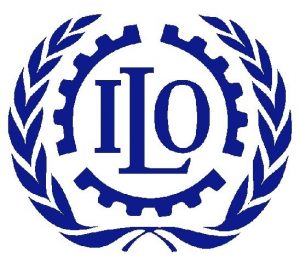
Making Women’s Work Visible: The 19th ICLS Standards, Purpose and Progress
This Data2X-ILO joint report builds on previous ILO reports on how new measurement approaches can help close gender data gaps in the world of work by further illustrating the differences between how women and men work and how improved measurement can support women’s economic empowerment.

Lessons from the COVID-19 pandemic: Gender relevance of the 19th ICLS statistical standards
This brief gives a summary overview of the impact of the introduction of the 19th ICLS statistical standards on labour statistics, as compared with the previous standards from the 13th ICLS. The key gender differences between the frameworks are illustrated using data collected from pilot studies completed between 2015 and 2017.

Lessons from the COVID-19 pandemic: Closing gender data gaps in the world of work – role of the 19th ICLS standards
This report provides a detailed overview of the relevance of the 19th ICLS for gender analysis of participation in work and the labour market. It uses data from the pilot studies completed between 2015 and 2017 to illustrate the wide range of analytical potential when the new standards are implemented.

Measuring women’s paid and unpaid work under ICLS 19
Why did the definitions of work and employment change and why is this change important for women? Find out in this policy brief.
Projects
In early 2021, the ILO Statistics Department started a three-year project to engender informality statistics, funded by the Bill & Melinda Gates Foundation. The project is running in parallel to the broader review of standards for informality statistics, currently undertaken through the ILO's Working Group on the Review of Informality Statistics. It supports integration of gender in the new standards, and the development of gender-related guidance and tools for measuring informality.
The main activity of the project is to test statistical concepts and household survey questionnaires, using cognitive interviewing in two countries in 2021 and a pilot field test in one country in 2022. The findings from those tests will support the working group in its discussions and drafting of the new standards, to be adopted by the 21st ICLS in 2023.
The project is also assessing the existing and anticipated needs for gender data on informality (data demand) and reviewing the use of data in strategy setting and policy formulation, making recommendations to strengthen the production, accessibility and use of gender statistics on informality.
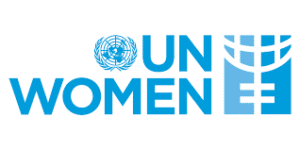
In 2019, the ILO partnered with UN-Women to create a series of novel labour market indicators, key to gender analysis. The main innovation resulting from this project was the inclusion of a variable on the household type in ILOSTAT, revealing how people's labour market outcomes change based on their family situation (whether they are single or not, whether they have children, the number and age of children, etc.).
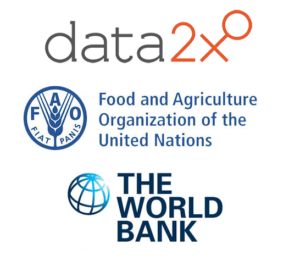
In 2014, the ILO partnered with the Food and Agriculture Organization and the World Bank under the Women’s Work and Employment Partnership, supported by Data2X, with the goal of addressing challenges in measuring work and employment to ensure that women are counted. The partnership supports research in two core areas: subsistence production and unpaid care work.
Methods

Gender Equality and Non-Discrimination Indicators (GEND database)
Concise description of concepts and definitions, uses, sources and limitations for indicators by household type, including presence and number of children.

Strengthening gender measures and data in the COVID-19 era: An urgent need for change
This brief highlights 5 key areas where strong and decisive action is required to achieve sustainable improvement in the availability of key gender data, including in the world of work.
Publications
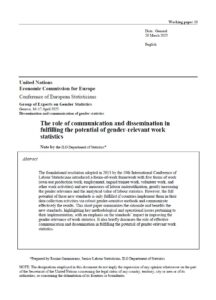
The role of communication and dissemination in fulfilling the potential of gender-relevant work statistics
The foundational resolution adopted in 2013 by the 19th International Conference of Labour Statisticians introduced a forms-of-work framework with five forms of work (own-use production work, employment, unpaid trainee work, volunteer work, and other work activities) and new measures of labour underutilization, greatly increasing the gender relevance and the analytical value of labour statistics. However, the full potential of these new standards is only fulfilled if countries implement them in their data collection activities via robust gender-sensitive methods and communicate effectively the results. This short paper summarizes the rationale and benefits the new standards, highlighting key methodological and operational issues pertaining to their implementation, with an emphasis on the standards’ impact in improving the gender relevance of work statistics. It also briefly discusses the role of effective communication and dissemination in fulfilling the potential of gender-relevant work statistics.


The impact of care responsibilities on women’s labour force participation
This brief provides a detailed overview and analysis of the new ILO global and regional estimates of persons outside the labour force due to care
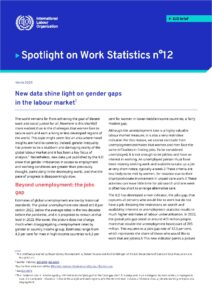
New data shine light on gender gaps in the labour market
A new indicator developed by the ILO finds that women’s access to employment, working conditions and pay gap have barely improved in the past two decades.
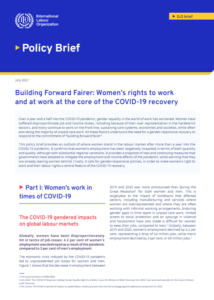
Building Forward Fairer: Women’s rights to work and at work at the core of the COVID-19 recovery
This policy brief provides an outlook of where women stand in the labour market after more than a year into the COVID-19 pandemic.

Spotlight on SDG 8: The impact of marriage and children on labour market participation
This publication, drawing on a global dataset and new indicators developed by the ILO and UN Women, shows that women’s employment is shaped by domestic and caregiving responsibilities in ways that men’s is not.

Care work and care jobs for the future of decent work
This report takes a comprehensive look at unpaid and paid care work and its relationship with the changing world of work. A key focus is the persistent gender inequalities in households and the labour market, which are inextricably linked with care work.
